| |
| |

Edouard MANET was born in
a wealthy family of magistrates on his father side and diplomats on his
mother side. After having failed the entrance examination to the Naval
College, he leaves France towards Rio in 1848 as a cadet on a
training ship.
Back in France, his father authorizes him
to devote himself to painting, towards which he had
felt attracted since his childhood. He compels him to follow a solid
formation at the School of Fine Arts in the Workshop of painter Thomas
COUTURE, where he was to remain during six long years.
Although he had suffered from Couture's method of teaching which
required "ideal and impersonality", he will keep for him all his
lifetime a certain respect.
"I paint what I see, and not
what others like to see" Edouard MANET used to say to
oppose to the academic doctrine, intending to assert his own
subjectivity and the importance of the vision of the painter compared
to the conventional rules.
|
|
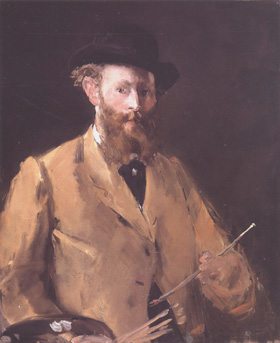
Self-portrait
with the palette
1879

Private Collection
|
Nevertheless, MANET would always grant a great value to the
humanistic heritage of meaningful painting and to
pictorial work on traditional themes, which, somewhere, makes him close
to COROT, considered as representative of an eclectic and historical
painting.
 A
CONTEMPORARY ACADEMIC PAINTING A
CONTEMPORARY ACADEMIC PAINTING
|
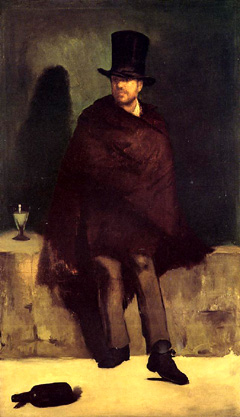
The absinthe
drinker
1858
Ny Carlsberg-Glyptotek,
Copenhague, Danemark
|
|
The early works of Manet are inspired by Dutch and
especially Spanish Painting of the XVIIth century.
Manet who accomplished many travels in Europe to study
the Old Masters was to be particularly influenced by the works of Dutch
Frans Hals and Spanish Diego Velasquez
and Francisco Jose de Goya .
His first submission to The Salon in 1859, "The
absinthe drinker", with a spanish resonance then very
fashionnable - Eugenie Empress was of Spanish origin -, was refused, in
spite of the favourable opinion of Delacroix, for the
main reason that MANET used a traditional pictorial configuration
(full-lenght portrait) to represent a marginal and socially discredited
person.
Thomas Couture was to condemn this painting by saying:
"does anyone paint something so ugly? My poor friend, there is only one
absinthe drinker here, and this is the painter who produced this
insanity "...
|
Manet had found a mode of creation which will characterize the
essence of his future production : to combine traditional
pictorial configurations and their expressive values with contemporary
reality. Thus, well before Impressionism itself, Manet poses
the terms of the artistic polemic to come : individual revolt against
academic rules, pictorial means put at the service of new contemporary
subjects...
At the beginning of the 1860s, Manet, at the manner of a stroller,
walks without respite through Paris which then changed from day to day,
to detect the most subtle characteristics, transformations, drawing in
his notebook "a detail, a profile, a hat, in a word a fugitive
impression".
Manet was accepted at the The Salon of 1861 with another more
accommodating painting in the spanish mode of the same style as "Lola
de Valence " (1862).
 EARLY BEGINNINGS of IMPRESSIONISM EARLY BEGINNINGS of IMPRESSIONISM
| |
On the other hand "Music at the Tuileries"
(1862)", a painting resulting from one of the strollings
of Manet, of light and open style, without centralizing
composition, that he presented at a personal exhibition was
negatively accepted, since contradicting the established necessity for
a finished pictorial form.
One however can see in this painting, by its subject,
its composition and its style, one of the ways of Impressionism which
was going to appear a few years later.
|
|
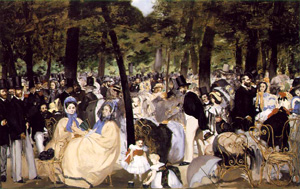
The music at
the Tuileries
1862
National Gallery, Londres
|
In 1863, he exhibits "The bath", which will be
renamed as "Luncheon on the grass" (Musée d'Orsay, Paris), at
the Salon des Refusés, a new place inaugurated by Napoleon III on the
artists' request, to exhibit works that were rejected at the official
Salon.
|
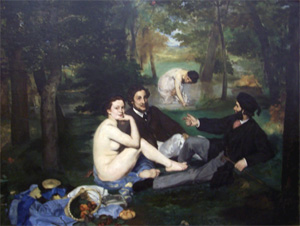
Luncheon on the
grass
1863
Musée
d'Orsay, Paris
|
|
This painting of Manet represents a scene of the Parisian
bohemian life of little accordance with the puritan morals of
that time : in a pastoral decoration, by a river, a young woman is
shown naked after a bath, her clothes posed beside her, between two men
in costume sitting for a picnic.
Here too, Manet transposes academic quotations in a
contemporary scene with an extraordinarily fertile modernity,
where many ones, at the time, only saw a lack of formal invention by
the artist.
|
This painting immediately drew the attention of the public
and was subject to sarcastic remarks. It will be violently attacked by
critics, and be the cause of a particular scandal inside the general
scandal caused by the Salon des Refusés.
Greeted by many young painters who admired him as an
innovating painter conscious of his effects, Manet was, a bit against
his will, at the center of an argument opposing the
defenders of academic art to the "refused" artists .
Manet, who had an ambition of bourgeois success, will suffer
all his life time that his painting, carried out by a great artistic
intuition, would only deserve him sulfurous notoriety,
but no official recognition.
| |
By 1864, the official Salon accepted two of his
paintings, and in 1865, he presented "Olympia"
(1863, Musée d'Orsay, Paris), a nude inspired from "The Venus of
Urbino" by Titien, which caused a scandal even bigger than "Luncheon
on the grass".
There too, Manet, quoting classics, represents a woman
who is supposed to be a divinity of the Renaissance referring to
Antiquity, as the luxury Parisian girl who had posed for model (Victorine
Meurent), with such a faithful realism and so
little in accordance with the puritain ideology of Second Empire, that
it raised waves of protest within the academic circles.
Manet who was aware to have accomplished something
important shall keep this painting until his death, and Claude Monet,
after Manet' death, will start a fund to prevent Manet' widow, then in
financial difficulty, from selling " Olympia " to an american buyer. "Olympia"
will enter the Louvre in 1893 .
|
|
|
|
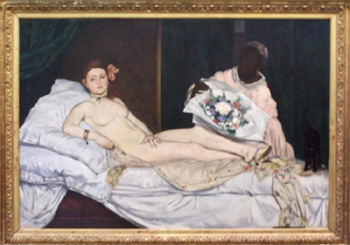
|
| |
|
Olympia
1863
Musée d'Orsay, Paris
|
 THE LEADER OF THE NEW SCHOOL THE LEADER OF THE NEW SCHOOL
From 1866, Emile Zola, who was going to
become his friend, will defend Manet' cause in "the Event" as well as
the new artistic school which he names "Naturalism".
During the second half of the 1860s, Manet became the most
respected painter of a group of artists, writers and art lovers, who
met at the "Café Guerbois", in the street of
Batignolles. The painter Fantin-Latour, after his "Homage
to Delacroix ", will paint "A workshop at the
Batignolles " (1870) where Manet appears in turn as the venerated
Master in front of a circle made of Zola, Astruc, Renoir,
Monet and Bazille.
If the young painters who were going to be the core of
Impressionism, Edgar Degas , Claude Monet , Auguste Renoir , Alfred
Sisley , Camille Pissarro and Paul Cézanne , underwent the influence of
Manet, those were in return to influence his art, making it more
sensitive to light and color effects.
Manet was still to paint several masterpieces in this decade,
such as "The fifre" (1866), "The
reading" (1865-73), "The rest" (1870).
In 1874, the artist chooses not to take part to the first Impressionist
show. He continued to exhibit regularly at the Salon where his
notoriety did not cease to grow. Manet may be seen as a powerful
inspirer rather than a strict representative of Impressionism,
of which he would always remain distinct.
 MANET SUPPORTS THE IMPRESSIONISTS MANET SUPPORTS THE IMPRESSIONISTS
Manet whose convictions were republican engaged in the
National Guard at the time of the war of 1870 and lived the Commune in
Paris.
Under the influence of his pupils, Berthe Morisot
and Eva Gonzalès, and of his Impressionist friends,
Manet was going to try out the painting of figures in natural light
with paintings such as "The railroad, Gare Saint-Lazare"
1872-73 or "On the beach" 1873 .
In 1874, the artist chooses not to take part in the first
Impressionist show. He will continue to regularly exhibit his works to
the Salon where his notoriety will not cease growing .
During the summer of 1874, Manet will visit Monet
and his family installed in Argenteuil opening
himself to Impressionism while painting in the open air. He painted
there "The Monet family at the garden", "Claude Monet
and his wife in his floating studio", "Argenteuil" .
Manet was going from now on to adhere completely to
Impressionism and to support Monet in particular, by
buying his paintings which Monet sold off 100 francs at that time, or
by tring to gain the art critic Wolff at Monet' art .
In 1877, Manet was again to cause criticisms with "Nana",
a representation of a young woman, in underskirts and blouse, powdering
herself in the presence of a man who awaits her, which will be refused
at the Salon.
|

A bar at the
Folies-Bergère
about 1881-82
Courtauld Institute Galleries
London
|
|
Manet will tardily gain some official recognition to
which he had aspired : he will become in 1881 one "out of contest" of
the Salon by obtaining a medal with "The portrait of Mr. Pertuisait"
, and will be made Chevalier of the Legion of Honour, on proposal of
his friend A. Proust, who had become Minister for the Arts.
In 1882, he was present for the last time at the Salon
with "A bar at the Folies-Bergères"
(Courtauld Institute Galleries, London), one of his most brilliant and
famous work.
|
|
He died in Paris on April 30, 1883,
leaving an important work, including more than four hundred oil paints,
many pastels and watercolours.
|
1832
|
Born in Paris on January 23 in an well-to-do
family of civil servants and officers. His father is a director at the
Ministry for Justice.
Edouard receives a good education and grows in a refined atmosphere
|
|
1844
|
Enters the Rollin College. Meets Antonin Proust.
|
|
1848
|
Fails the entrance Examination to the Naval
college, leaves to Rio on a training ship
|
|
1849
|
Remains in Rio , then goes back to Paris.
|
|
1850
|
Enters the Fine Arts School
Follows courses in the Workshop of Thomas Couture and makes copies at
the Louvre.
|
|
1852
|
Has a son, Leon, of Suzanne Leenhoff , a Dutch
piano teacher, whom he will marry only in 1863
Officially, hisr son Leon-Edouard Leenhoff, who will his model on many
occasions, was introduced as the little brother of Suzanne and the
godson of Manet
|
|
1853
|
Travels throughout Europe, to
Holland, to Germany, to Italy, where he visits the great museums
|
|
1855
|
Meets Delacroix in his workshop
within Notre-Dame.
|
|
1856
|
Leaves the Workshop of Couture to create to his
own workshop
Visits Rijksmuseum in Amsterdam.
|
|
1857
|
Meets Fantin-Latour in the Louvre. Travels to
Italy.
|
|
1858
|
Meets Charles Baudelaire .
|
|
1859
|
' The absinthe drinker' is
refused at the The Salon.
Moves in a new workshop
|
|
1860
|
Moves in with Suzanne and Leon in an apartment at
the Batignolles.
Becomes an accustomed member of the Café Guerbois.
|
|
1861
|
Exposes for the 1st time to The Salon with a "Portrait
of Mr.et Mrs. Manet" and "The Spanish singer" which
receives a honorable mention
Meets with Degas
|
|
1862
|
Death of Manet's father.
Manet paints "Musique at the Tuileries" and meets Victorine
Meurent , who will be the model of the " Luncheon on the grass " and
of "Olympia".
|
|
1863
|
Exposes " Luncheon on the grass "
at the The Salon des Refusés.
Manet marries Suzanne in Holland
|
|
1864
|
Exposes "Corrrida scene" at the Salon.
|
|
1865
|
"Olympia" causes a
scandal within the Salon.
Travels to Spain
|
|
1866
|
"The fifre" and "The
tragic actor" are refused at the Salon.
Meets with Cézanne and Monet .
|
|
1867
|
Holds a major personal exhibition in margin of the
"Universal Exhibition".
Paints the first version of "The execution of Maximilian Emperor"
.
|
|
1868
|
Meets Berthe Morisot.
Paints the "Portrait of Emile Zola" .
|
|
1869
|
Eva Gonzales becomes his pupil and model.
Exposes "The balcony" at the Salon, but the
final version of the "Execution of Maximilien Emperor" is
refused
|
|
1870
|
Franco-Prussian War. Manet joins the National
Guard.
|
|
1871
|
Is in Paris during the Commune of Paris.
|
| 1872
|
Travels to Holland |
|
1873
|
"The Good Glass of
bier" is exposed to the Salon.
Meets Stéphane Mallarmé .
|
|
1874
|
Declines the proposal to take part in the 1st
exhibition of Impressionists.
His brother Eugene Manet marries Berthe Morisot.
Spends the summer painting with Monet in Argenteuil
|
|
1875
|
Exposes "The Seine at Argenteuil"
at the Salon.
Travels To Venice.
|
|
1876
|
Paints "The Portrait of Stéphane Mallarmé"
.
|
|
1877
|
"Nana"
is refused at the Salon.
|
|
1878
|
Paints "Autoportait with the cap" .
|
|
1880
|
"Portrait of Antonin Proust" is shown at
the Salon.
|
|
1881
|
Antonin Proust becomes Minister for the Culture.
Manet receives the "Legion of Honor"
|
|
1882
|
His health worsens.
"A Bar at the Folies-Bergères" is
shown at the Salon.
|
|
1883
|
Amputation of his left leg on April 19. Dies on
April 30
|
|
1893
|
Olympia enters the Louvre Museum
|
|
|



